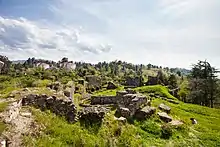Siege of Petra (550–551)
A Siege of Petra (550–551) was conducted by the Byzantines under general Bessas against the Sasanian garrison at Petra, Lazica, during the Lazic War. Sasanian reinforcements failed to arrive in time and Petra fell after a lengthy siege. Its fortifications were also dismantled to ensure that this strategic stronghold was never going to be used by the Sasanians again.
| Siege of Petra | |||||||
|---|---|---|---|---|---|---|---|
| Part of the Lazic War | |||||||
| |||||||
| Belligerents | |||||||
|
Byzantine Empire Sabirs | Sasanian Empire | ||||||
| Commanders and leaders | |||||||
| Bessas | Mirranes | ||||||
| Strength | |||||||
| 6,000 | 2,600 | ||||||
Background
After the failure of Dagisthaeus in his siege of Petra in 549, Justinian I replaced him by Bessas as the magister militum per Armeniam, a decision that was criticized by the Byzantines due to the latter's old age and "inglorious" record during the sack of Rome in 546.[1][2][3]
Siege

The Byzantines under Bessas, allied with Sabirs, numbering 6,000 in total, laid siege to Petra in 550. The Sasanian garrison, numbering 2,600, was reportedly "brave and resolute", lengthening the siege more than a year.[1][2][3] During the fightings, the Sasanians used fire pots containing sulfur and bitumen.[4] Mihr-Mihroe and his army of cavalry and eight elephants were on their way to yet again relieve the siege on Petra, but he was too late this time. Bessas finally managed to capture Petra in spring of 551. According to Procopius, he personally attacked the walls in an act of courage despite his old age. A small remaining Sasanian force in the acropolis refused his offer of surrender, and Bessas ordered the citadel to be torched. A large amount of Sasanian supplies and equipment were captured, showing that the Sasanians had intended to maintain the city in their hands. Bessas then dismantled the fort, as ordered by Emperor Justinian I.[1][2][3]
Aftermath
After Petra's fall, Mihr-Mihroe directed his force against the Byzantine forts in the area, capturing Sarapanis and Scanda. Allied with 4,000 Sabir Huns, he tried to capture the main Byzantine stronghold of Archaeopolis, but, although the Dailamite foot-soldiers and the war elephants were tactically effective, the assault was eventually unsuccessful, as many of his forces died due to lack of supplies.[3][2]
References
- Jones, Arnold Hugh Martin; Martindale, J. R.; Morris, J. (1980). The Prosopography of the Later Roman Empire: Volume 2, AD 395-527. Cambridge University Press. p. 228. ISBN 9780521201599.
- Greatrex, Geoffrey (2007). The Roman Eastern Frontier and the Persian Wars Ad 363-628. Psychology Press. p. 118-119. ISBN 9780415465304.
- Evans, J. A. S. (2002). The Age of Justinian: The Circumstances of Imperial Power. Routledge. p. 167. ISBN 9781134559763.
- Elton, Hugh (2018). The Roman Empire in Late Antiquity: A Political and Military History. Cambridge University Press. p. 326. ISBN 9780521899314.
